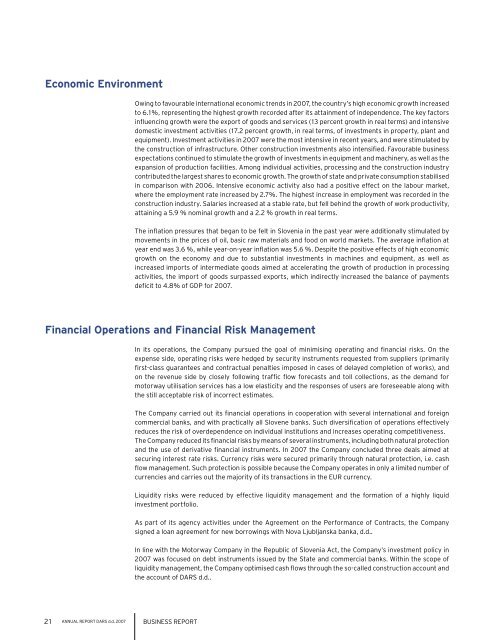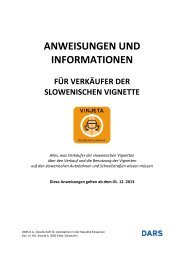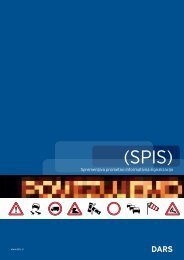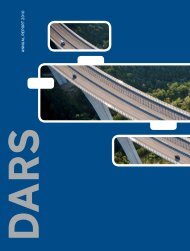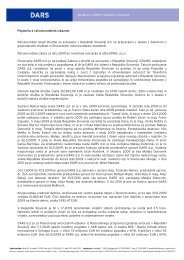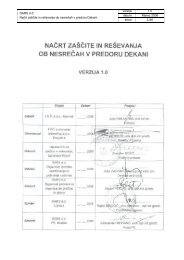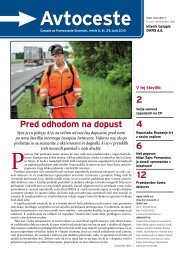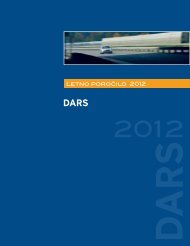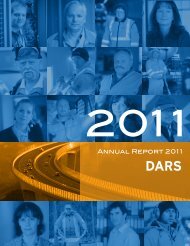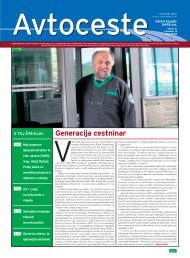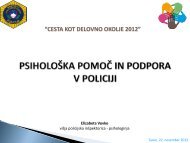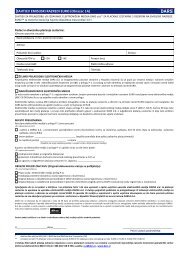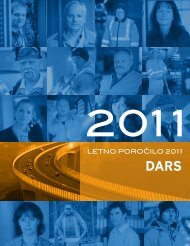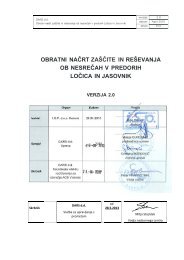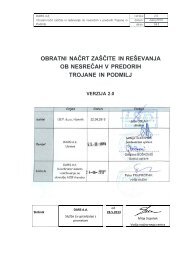DARS_porocilo 2007 ANG.indd
DARS_porocilo 2007 ANG.indd
DARS_porocilo 2007 ANG.indd
- No tags were found...
Create successful ePaper yourself
Turn your PDF publications into a flip-book with our unique Google optimized e-Paper software.
Economic Environment<br />
Owing to favourable international economic trends in <strong>2007</strong>, the country’s high economic growth increased<br />
to 6.1%, representing the highest growth recorded after its attainment of independence. The key factors<br />
influencing growth were the export of goods and services (13 percent growth in real terms) and intensive<br />
domestic investment activities (17.2 percent growth, in real terms, of investments in property, plant and<br />
equipment). Investment activities in <strong>2007</strong> were the most intensive in recent years, and were stimulated by<br />
the construction of infrastructure. Other construction investments also intensified. Favourable business<br />
expectations continued to stimulate the growth of investments in equipment and machinery, as well as the<br />
expansion of production facilities. Among individual activities, processing and the construction industry<br />
contributed the largest shares to economic growth. The growth of state and private consumption stabilised<br />
in comparison with 2006. Intensive economic activity also had a positive effect on the labour market,<br />
where the employment rate increased by 2.7%. The highest increase in employment was recorded in the<br />
construction industry. Salaries increased at a stable rate, but fell behind the growth of work productivity,<br />
attaining a 5.9 % nominal growth and a 2.2 % growth in real terms.<br />
The inflation pressures that began to be felt in Slovenia in the past year were additionally stimulated by<br />
movements in the prices of oil, basic raw materials and food on world markets. The average inflation at<br />
year end was 3.6 %, while year-on-year inflation was 5.6 %. Despite the positive effects of high economic<br />
growth on the economy and due to substantial investments in machines and equipment, as well as<br />
increased imports of intermediate goods aimed at accelerating the growth of production in processing<br />
activities, the import of goods surpassed exports, which indirectly increased the balance of payments<br />
deficit to 4.8% of GDP for <strong>2007</strong>.<br />
Financial Operations and Financial Risk Management<br />
In its operations, the Company pursued the goal of minimising operating and financial risks. On the<br />
expense side, operating risks were hedged by security instruments requested from suppliers (primarily<br />
first-class guarantees and contractual penalties imposed in cases of delayed completion of works), and<br />
on the revenue side by closely following traffic flow forecasts and toll collections, as the demand for<br />
motorway utilisation services has a low elasticity and the responses of users are foreseeable along with<br />
the still acceptable risk of incorrect estimates.<br />
The Company carried out its financial operations in cooperation with several international and foreign<br />
commercial banks, and with practically all Slovene banks. Such diversification of operations effectively<br />
reduces the risk of overdependence on individual institutions and increases operating competitiveness.<br />
The Company reduced its financial risks by means of several instruments, including both natural protection<br />
and the use of derivative financial instruments. In <strong>2007</strong> the Company concluded three deals aimed at<br />
securing interest rate risks. Currency risks were secured primarily through natural protection, i.e. cash<br />
flow management. Such protection is possible because the Company operates in only a limited number of<br />
currencies and carries out the majority of its transactions in the EUR currency.<br />
Liquidity risks were reduced by effective liquidity management and the formation of a highly liquid<br />
investment portfolio.<br />
As part of its agency activities under the Agreement on the Performance of Contracts, the Company<br />
signed a loan agreement for new borrowings with Nova Ljubljanska banka, d.d..<br />
In line with the Motorway Company in the Republic of Slovenia Act, the Company’s investment policy in<br />
<strong>2007</strong> was focused on debt instruments issued by the State and commercial banks. Within the scope of<br />
liquidity management, the Company optimised cash flows through the so-called construction account and<br />
the account of <strong>DARS</strong> d.d..<br />
21 ANNUAL REPORT <strong>DARS</strong> d.d. <strong>2007</strong> BUSINESS REPORT


